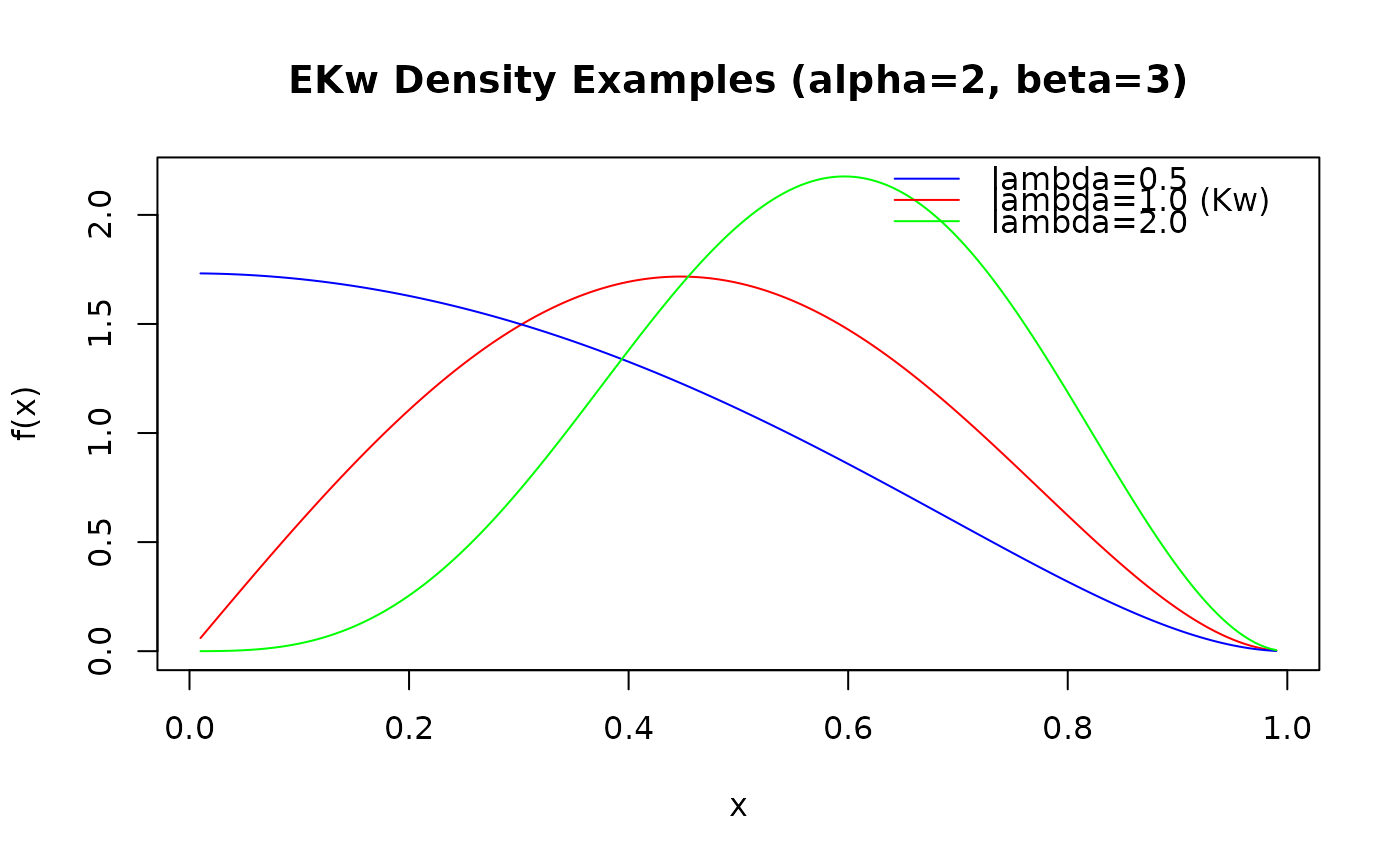Computes the probability density function (PDF) for the Exponentiated
Kumaraswamy (EKw) distribution with parameters alpha (\(\alpha\)),
beta (\(\beta\)), and lambda (\(\lambda\)).
This distribution is defined on the interval (0, 1).
Arguments
- x
Vector of quantiles (values between 0 and 1).
- alpha
Shape parameter
alpha> 0. Can be a scalar or a vector. Default: 1.0.- beta
Shape parameter
beta> 0. Can be a scalar or a vector. Default: 1.0.- lambda
Shape parameter
lambda> 0 (exponent parameter). Can be a scalar or a vector. Default: 1.0.- log_prob
Logical; if
TRUE, the logarithm of the density is returned (\(\log(f(x))\)). Default:FALSE.
Value
A vector of density values (\(f(x)\)) or log-density values
(\(\log(f(x))\)). The length of the result is determined by the recycling
rule applied to the arguments (x, alpha, beta,
lambda). Returns 0 (or -Inf if
log_prob = TRUE) for x outside the interval (0, 1), or
NaN if parameters are invalid (e.g., alpha <= 0,
beta <= 0, lambda <= 0).
Details
The probability density function (PDF) of the Exponentiated Kumaraswamy (EKw) distribution is given by: $$ f(x; \alpha, \beta, \lambda) = \lambda \alpha \beta x^{\alpha-1} (1 - x^\alpha)^{\beta-1} \bigl[1 - (1 - x^\alpha)^\beta \bigr]^{\lambda - 1} $$ for \(0 < x < 1\).
The EKw distribution is a special case of the five-parameter
Generalized Kumaraswamy (GKw) distribution (dgkw) obtained
by setting the parameters \(\gamma = 1\) and \(\delta = 0\).
When \(\lambda = 1\), the EKw distribution reduces to the standard
Kumaraswamy distribution.
References
Nadarajah, S., Cordeiro, G. M., & Ortega, E. M. (2012). The exponentiated Kumaraswamy distribution. Journal of the Franklin Institute, 349(3),
Cordeiro, G. M., & de Castro, M. (2011). A new family of generalized distributions. Journal of Statistical Computation and Simulation,
Kumaraswamy, P. (1980). A generalized probability density function for double-bounded random processes. Journal of Hydrology, 46(1-2), 79-88.
Examples
# \donttest{
# Example values
x_vals <- c(0.2, 0.5, 0.8)
alpha_par <- 2.0
beta_par <- 3.0
lambda_par <- 1.5 # Exponent parameter
# Calculate density
densities <- dekw(x_vals, alpha_par, beta_par, lambda_par)
print(densities)
#> [1] 0.5631989 1.9246241 0.9110922
# Calculate log-density
log_densities <- dekw(x_vals, alpha_par, beta_par, lambda_par, log_prob = TRUE)
print(log_densities)
#> [1] -0.57412239 0.65473067 -0.09311121
# Check: should match log(densities)
print(log(densities))
#> [1] -0.57412239 0.65473067 -0.09311121
# Compare with dgkw setting gamma = 1, delta = 0
densities_gkw <- dgkw(x_vals, alpha_par, beta_par, gamma = 1.0, delta = 0.0,
lambda = lambda_par)
print(paste("Max difference:", max(abs(densities - densities_gkw)))) # Should be near zero
#> [1] "Max difference: 3.33066907387547e-16"
# Plot the density for different lambda values
curve_x <- seq(0.01, 0.99, length.out = 200)
curve_y1 <- dekw(curve_x, alpha = 2, beta = 3, lambda = 0.5) # less peaked
curve_y2 <- dekw(curve_x, alpha = 2, beta = 3, lambda = 1.0) # standard Kw
curve_y3 <- dekw(curve_x, alpha = 2, beta = 3, lambda = 2.0) # more peaked
plot(curve_x, curve_y2, type = "l", main = "EKw Density Examples (alpha=2, beta=3)",
xlab = "x", ylab = "f(x)", col = "red", ylim = range(0, curve_y1, curve_y2, curve_y3))
lines(curve_x, curve_y1, col = "blue")
lines(curve_x, curve_y3, col = "green")
legend("topright", legend = c("lambda=0.5", "lambda=1.0 (Kw)", "lambda=2.0"),
col = c("blue", "red", "green"), lty = 1, bty = "n")
 # }
# }